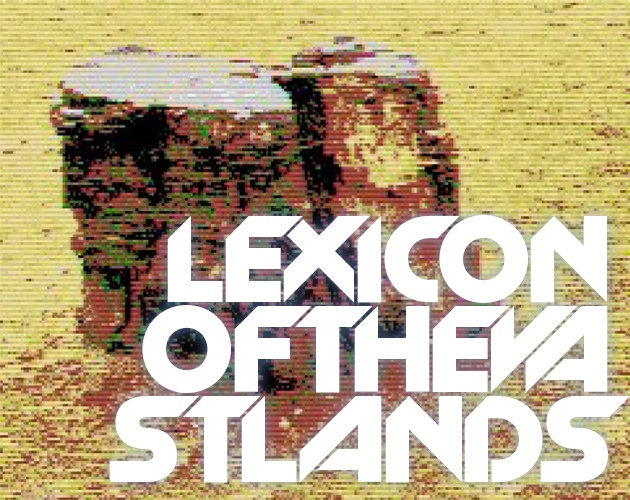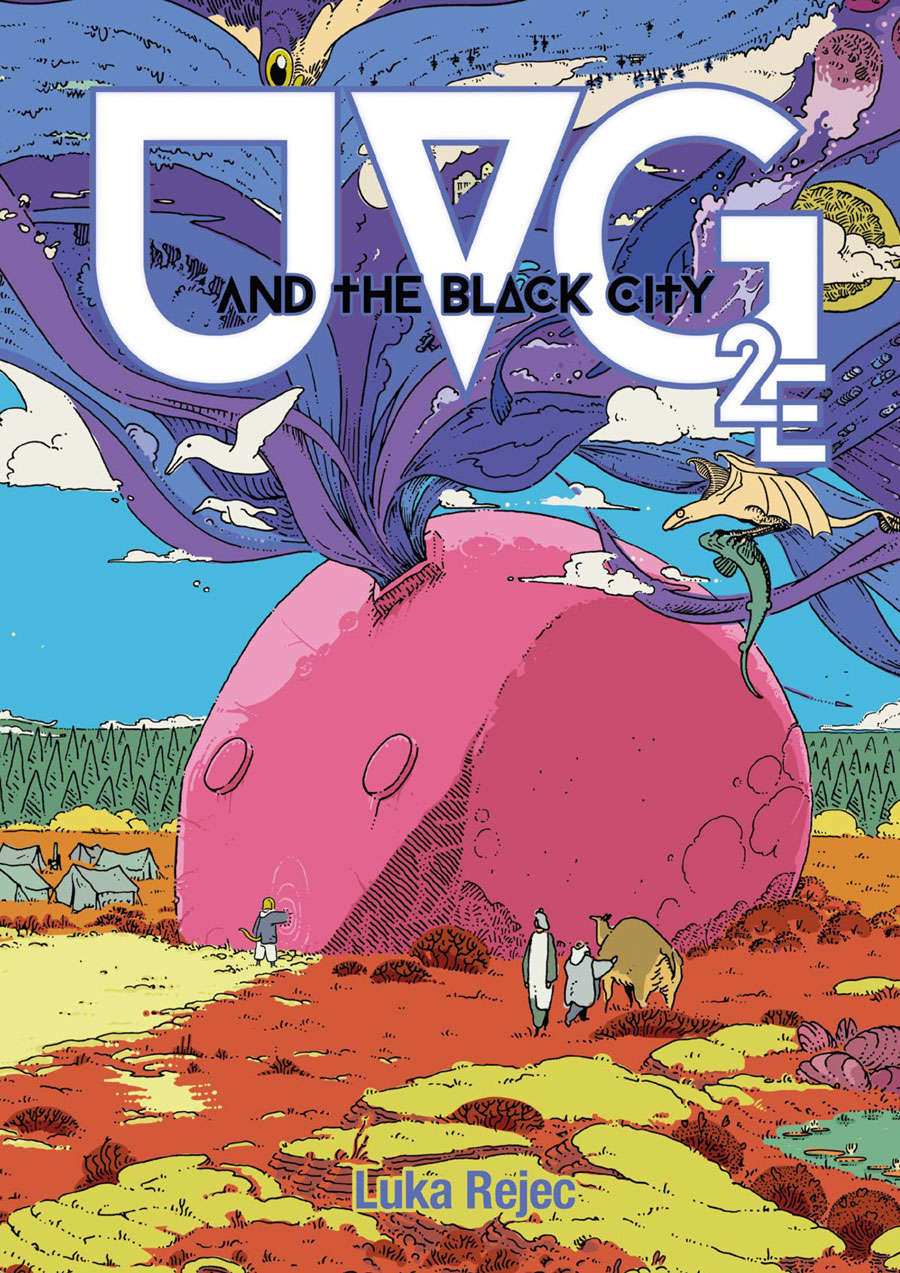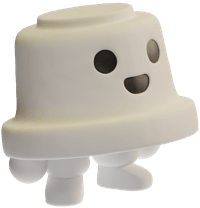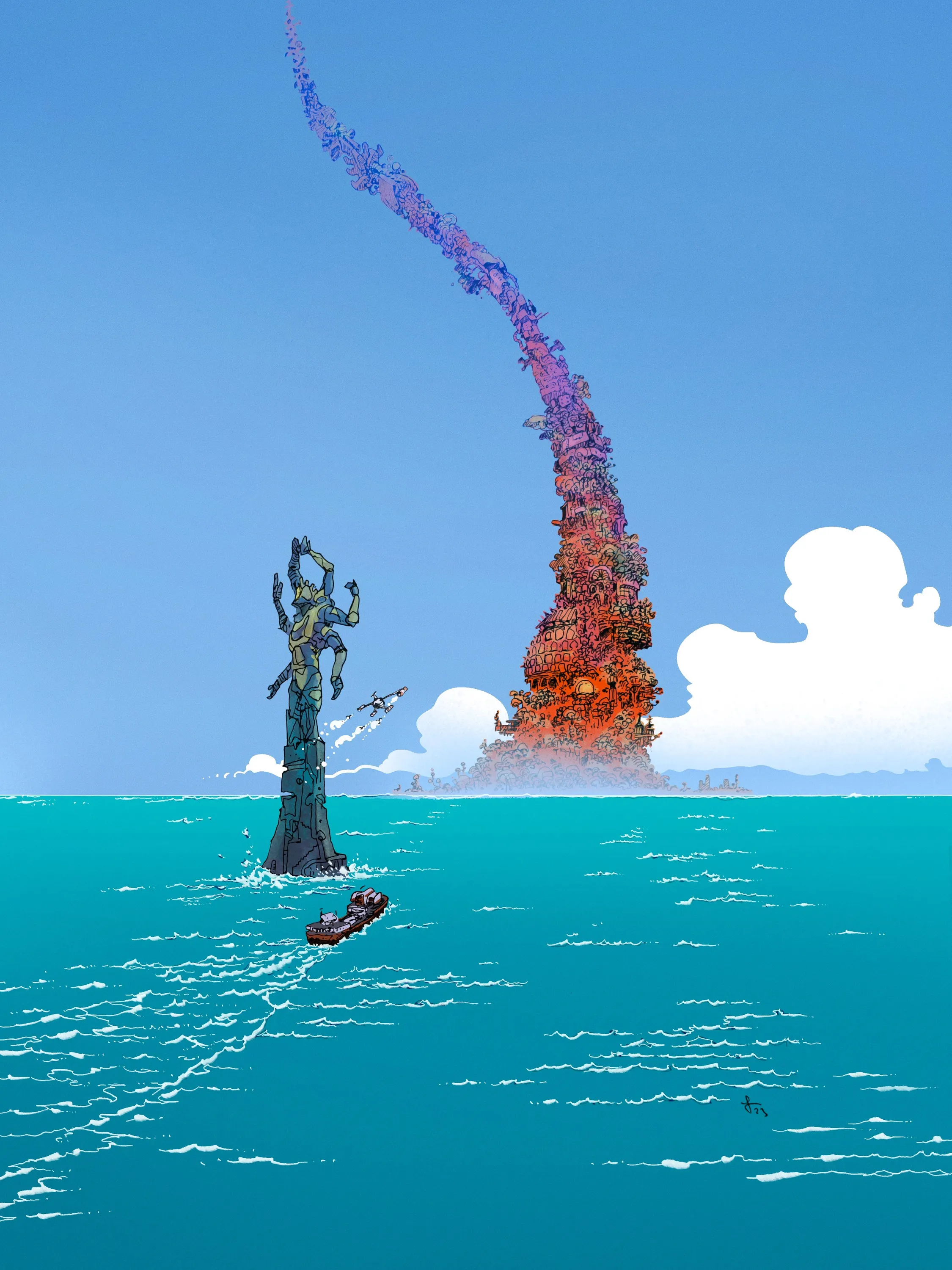
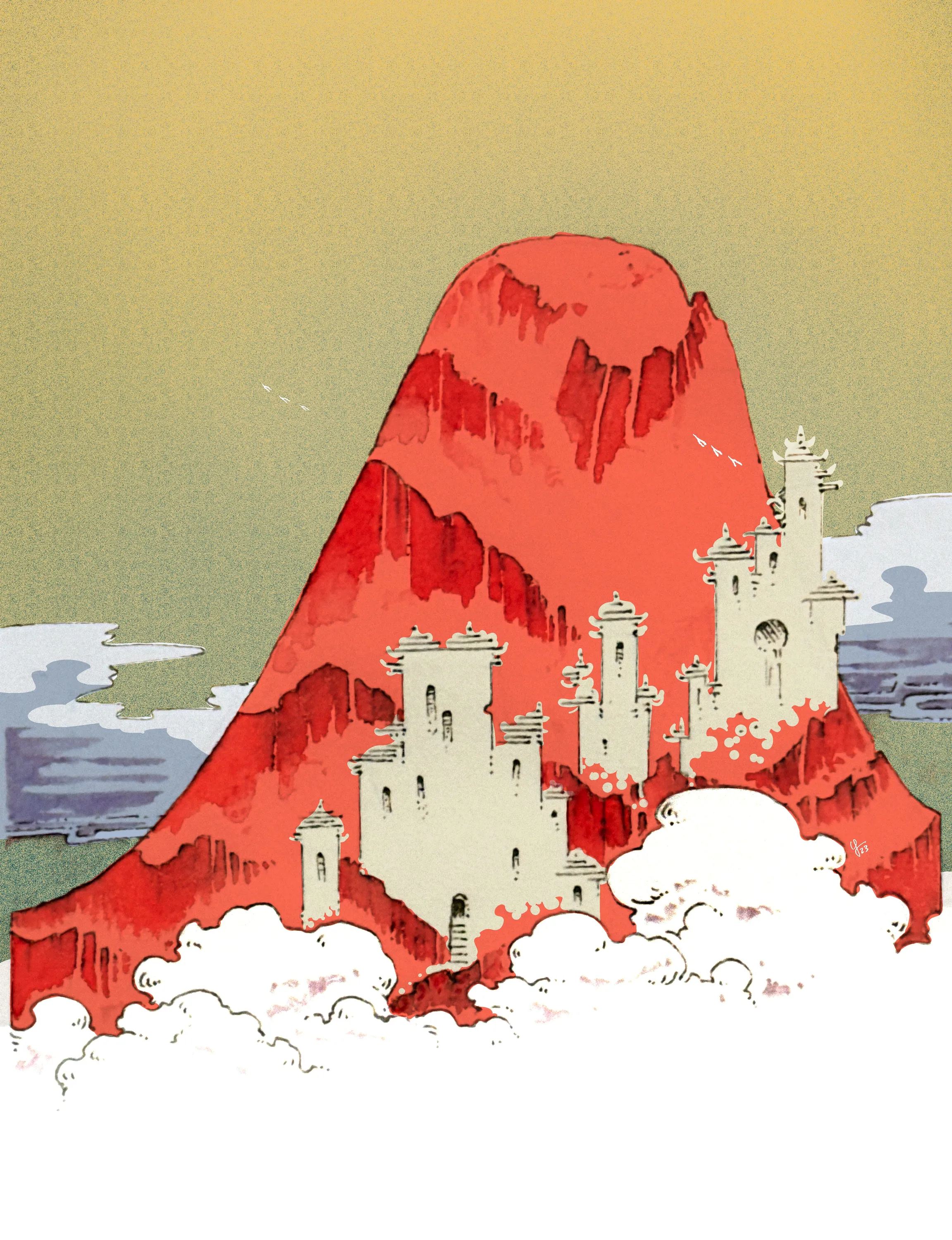
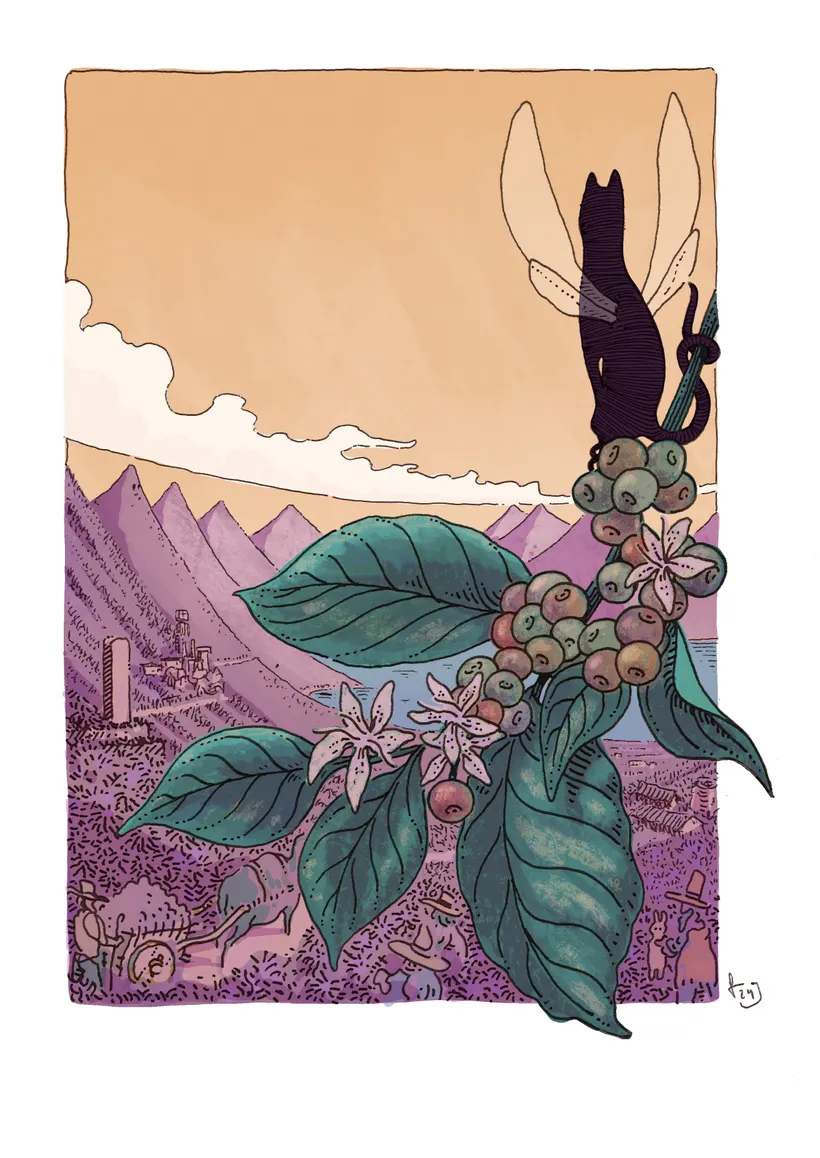
SDM Links
Dice
Synthetic Dream Machine Wiki
Inventory
Oracles
Characters
Core Rules
Bestiary
Creatures and Non-Player Characters (NPCs) should be simple to run, yet memorable to encounter.
Mounts and Vehicles
Smart players quickly realize that carrying their own supplies is not a good idea. If they do not realize this tell them to get two mules each to be on the safe side.
Companies
The company is a group character for the Player Daemons, a joint mobile base of operations. The most common type of company in the Ultraviolet Grasslands is the Caravan. You don’t need a caravan to travel the UVG, but it’s a good idea.
Equipment
Sufficiently advanced magics indistinguishable from technology abounds, if unevenly distributed. This space describes items and how to equip starting characters.
Traits
There are secret advanced sciences, indistinguishable from magic, that offer mastery over the worlds of matter and mind. “All these spells, these powerful magics, my hero shall master!” gloats the daemon. Why must it threaten you with such corruption? Truly, knows it no mercy?
Character Creation
The Player Daemons have chosen their Characters. These will serve as our protagonists and the focus of the core of the rules.
Save
When nothing but blind luck will save a PC, they roll d20 + ability over their saving roll target (or simply, their save). If they succeed, they are saved. Your save is 13. As with other rolls, there are three possible outcomes:
Under 13 Doom. What was, will be. No save.
Exactly 13 Sacrifice. Lose something precious to save.
Over 13 Save. Disaster averted, fortune appeased.
3) a new trait, power, or complication (for example, an added resistance).
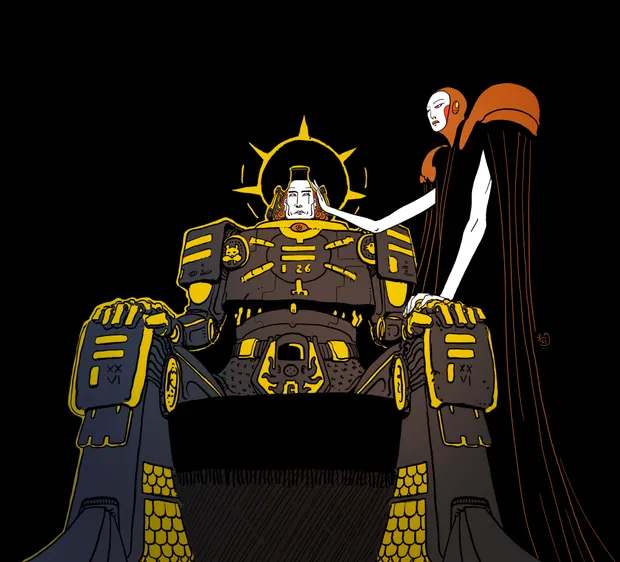
a psychedelic roleplaying game
Synthetic Dream Machine Kinopio Spaces
Throughout this space you will see portal-links to other spaces, marked with an arrow next to the pin-circle and a title below the card. Click the arrow to travel to that space. If the space name starts with /Synthetic Dream Machine/ it is a space in the Synthetic Dream Machine Wiki on kinopio.club. Use the SDM Links box in each space (see below) to navigate around to the core rules.
System Introduction
The Synthetic Dream Machine (SDM) system is a fast and loose OSR system. It assumes familiarity with other traditional roleplaying games, like the original game with 20-sided dice, OSE, Mothership, ItO, Knave, Cairn, etc. SDM is the core rules system that powers Ultraviolet Grasslands, Our Golden Age, Elyncia: Flying Triremes and Laser Swords, and other psychedelic roleplaying games. This version of SDM incorporates the UVG Guide Book materials.
Introduction
Welcome, curious explorer, to the Ultraviolet Grasslands. To a time beyond the end of time. To the psychedelic steppes beyond the edge of civilization. The utter west, the deep, vast, mythic steppe littered with the detritus of time and space and memory.
The UVG is a point-crawl setting inspired by psychedelic heavy metal, the Dying Earth genre, and Oregon Trail games. It is a world colored by new wave science fiction and inspired by artists from Moebius to Miyazaki.
This updated guide for the 2nd edition of the UVG, and the Synthetic Dream Machine system, covers character creation, rules and mechanics, equipment and powers, refereeing and cocreation, adventures and encounters, and more.
You can get the Ultraviolet Grasslands in deadwood via Exalted Funeral Press and a number of friendly local gaming stores. The electronic paper version is also available online at DTRPG and itch.io. Several translations are also available (or in progress).
The Traveler is a PC in the best tradition of roleplaying.
The Anti-Canon Reader
As the referee, your job is not to master a vast setting and bizarre lore, but to present scenes and pose challenges, to apply rules and arbitrate outcomes. You’re the bass player, setting the rhythm of the game.
In the UVG, in the Vastlands, you are on the journey together with your players: discovering the world and what happens in it. There is no one proper UVG. No one canon. No true, proper way to play it.
The game at your table belongs to you all, players and referee. Through play, you discover a world and create a canon of your very own.
Safe travels beyond the edge of the last safe world.
UVG Origins
The roots of the UVG are in the Rainbowlands that grew collaboratively from the games I ran for the Golden Goats of Lausanne in the early to mid 2010s. Thank you good players for amazing adventures and delightful dinners.
The UVG and the Rainbowlands and the rest of the Vastlands I’ve published are not quite the same as those I ran then. They could not be.
But, like all the fine history, art, and wine, they rhyme.
The Synthetic Dream Machine
Creation and destruction, an endless cycle, looped so many times the history’s become a fog. No apocalypse remains. No post comes anymore. Eras upon eras, worlds upon worlds, like grains of sand upon the beach of cosmic awareness.
Optimism. Life. New beginnings from the primordial ooze of barbarism. From the planetary vents of life. Again, again, again.
Rain falls on mountains. Streams become rivers. Lakes meet seas. Tribes become cities. Prophets found kingdoms. Explorers cross horizons. Merchants bind cultures. Empires cross continents. Shamans ascend to the stars. Life spreads from fast star to slow star. Wanderers tunnel the wormways through the ever void.
All must come to pass in the infinite cosmoses.
Eternity eats the unwise.
There is more to the universe than this Circle Sea and the Ultraviolet Grasslands so familiar to the Rainbowlanders.
Synthetic Dream Machine (SDM) and Ultraviolet Grasslands (UVG) are copyright Luka Rejec. Other materials are independent productions by their Author or Publisher, and are not affiliated with Luka Rejec or WTF Studio. Additional rules and compatible games are published under the Synthetic Dream Machine Third Party License.
By Luka Rejec
The World’s Edge
A world begins when it emerges from the mists of time. So it is with the civilizations of the Rainbowlands—which mark their count from when the Long Ago ended and the Now began.
The Rainbowlanders are the humans of a later era, undisputed masters of the fertile lands around the Circle Sea, dwellers in the Eye of Creation, in the Garden of the Given World. They come in many shapes, colours, creeds, and faiths. They pile unkempt technology and misremembered lore together into a teetering whole. They rule the settled lands under their polychrome deities of ill-repute.
This story is not theirs. This story begins at the edge of their world, at the Left End of the Right Road. At the westernmost outpost of humanity, the Violet City: bastion against the hordes, entrepôt to the exotic sunset lands, and last port of civilization before the trackless steppe studded with the detritus of the Long Ago.
The last glimmer of the Rainbow before the skin-blistering glow of the Ultraviolet Grasslands.
Half setting, half adventure, and half epic trip;
Drag Away an Ally. Get your friend to safety. If they are conscious, they might struggle, forcing a strength roll.
Protect. Bat away blows against a target. Attacks against it are rolled with a penalty.
Shake Off. Attack an enemy that has grabbed or pinned you.
Shake Off. Attack an enemy that has grabbed or pinned you.
Hold Down. Smaller? Make a strength roll to pin down a grabbed target. A pinned creature can’t move or attack anyone except you.
Hold Down. Smaller? Make a strength roll to pin down a grabbed target. A pinned creature can’t move or attack anyone except you.
Hang On. A kaiju lumbering away? Roll endurance or agility to hang on.
Grab On. Grab hold of a target. Probably requires a strength or agility roll. It can’t move away without dragging you along.
Sneak Away. If enemies can’t see you, you can move to a different location and surprise them. Or flee without getting attacked.
Sneak Away. If enemies can’t see you, you can move to a different location and surprise them. Or flee without getting attacked.
Hide. Make yourself discreet, so you can’t be targeted. Requires suitable cover or camouflage gear and a successful agility or thought roll.
Take Cover. You dive behind suitable terrain. Ranged attacks against you suffer a penalty.
Activate an Item Ponder an Orb. Activate a Magitech/Sorcery-warded Door. Or unlock a regular one that doesn’t say whoosh.
Pick a Pocket. Or a Peck of Pickled Peppers.
Swap Tools. Carefully stow the gear you’re using and ready something else. You can rush it: toss your current gear to the ground, pull out a hidden pistol, and use it with a penalty.
Communication. Command a golem, convey a complicated plan, or check instructions in the nöospheric post you have received.
Chug Potion. You drink a potion. Or apply an ointment. Or slap on a healing parasite.
Control Power. Not all powers are fire-and-forget affairs. Some, such as Waxni’s Magic Cruise Missile, require active control.
Use Power. Also sometimes known as casting a spell.
Tactical and Support Actions
Furious Attacks. Roar as you unload your magazine into the monstrous rabbit of Blaargh. Spend your turn hacking away like a human possessed. No moving, no tactics, and your foes get a bonus against you on their turn. But you attack twice.
Suppressing Fire. Lay down arrows, bullets, or maser blasts, imposing a penalty on your foes’ rolls.
Ready Attack. Prepare to counterattack if a foe comes in range. If that happens, your attack resolves before your enemy’s. If it doesn’t come in range, your attack is wasted. The referee can use oracle dice to decide what enemies do, to keep things fair.
Careless Attack. Attack with no regard for your safety. Get a bonus on your attack, but if your enemy survives they get a free counterattack.
Skirmish. You hop from behind cover, get off a round, and hop back. The mobility isn’t great, but cover protects.
Attack. An adjacent foe with a melee weapon, or a more distant enemy with a suitable ranged weapon.
Attack Actions Attacks are actions taken to directly damage your foes. The SDM rules documents mention four types of attacks: melee, ranged, oldtech (magitech), and fantascience (sorcery). Other types are possible. Traits and gear can unlock attacks with special effects, bonuses against certain kinds of targets, in certain environments, or from a character’s abilities.
Movement Actions You’re mostly moving around, maybe doing something else not too involved, like unholstering a carbine, reloading a carbine, or wondering whether you left your stove on when you left your house this morning to explore the sewers.
Disengage. Carefully, guarding against counterattacks, you back away from close combat. You move nearby, just out of reach.
Flee. Carelessly, you turn your back on your melee opponent and head far away. Your foe gets a free attack. Probably with a bonus. Foes with guns may also get free attacks. Beware.
Move. You move nearby. Right there. No sweat, just a nice easy walk. You could combine this with a weapon readied to catch foes doing funny stuff.
Sprint. You move somewhere further away, over there. Just as fast as you can. Look out, you might trip on some obstacles and if there are enemies about, they may get a free attack.
Sprint. You move somewhere further away, over there. Just as fast as you can. Look out, you might trip on some obstacles and if there are enemies about, they may get a free attack.
Charge. You rush a nearby creature, getting a bonus to your attack. Attacks against you also get a bonus until your next turn.
Charge. You rush a nearby creature, getting a bonus to your attack. Attacks against you also get a bonus until your next turn.
Climb Climb a Ladder. Depending on ladder length, that’s probably the only thing you’ll reasonably do this turn.
Drive. Or direct a riding ostrich. Steering and not crashing.
When the whole group is trying to accomplish something risky, a random PC rolls for the whole group. The referee may call for the player to roll for an NPC selected to represent their group. Some traits will allow specific characters to roll tests for their group, or modify this rule.
Group Roll When a group endeavors together, a random one rolls. —Ederacts d4:d20
Roll When It Counts With certain activities, only roll when it counts. These are long duration things like hiding, moving stealthily, gossiping politely, participating in society dance, standing guard over a prisoner all night, etc.
Assume Competence The PCs can try to do anything that makes sense in their situation. They are not limited to the traits and items listed on their character sheets, which represents the resources they bring to the situation. Their local environment may offer other resources. Traits or items may allow alternate abilities in specific situations. When the PC lacks a required trait for a task, the referee assigns a penalty as they see fit.
Automatic Success With Suitable Equipment A character with suitable equipment and few time constraints can succeed at tasks of an ordinary difficulty without rolling.
Suitable and Unsuitable Equipment Under pressure, the referee can impose a penalty on characters without suitable equipment for tasks they are otherwise skilled at. Conversely, having precisely the right equipment can provide a bonus. The referee makes the final decision.
+1/-1 a tiny bonus or penalty +6/-6 a rather large bonus or penalty +1d6/-1d6 a pretty random bonus or penalty advantage roll twice and take the better result disadvantage roll twice and take the worse result
Bonus and Penalty The referee assigns a bonus [+] or penalty [-] when circumstances favor or hinder a PC. Traits, items, events, burdens, and more also give [+] or [-]. The referee decides when and how different bonuses and penalties combine.
Roll on Target - Force a Situation When a player rolls precisely on target, they can sacrifice something to succeed. The referee may suggest a sacrifice, including:
Magic Numbers Some natural rolls on the d20 are special. 1 Fail and equipment notched. Mark. Mark again, it is broken. 13 Only one ammo or power unit left. Mark. One use left. 20 Always succeed. Double effect or additional stunt (trip, trick, trap), then roll a bonus action.
Typical Target Numbers 3 Trivial, casual, banal 7 Easy, simple, routine 11 Mediocre, moderate, average, medium 15 Hard, challenging, tasking 19 Very hard, confounding, risky
ROLL When PCs try something risky, they roll d20 + ability + skill and try to beat a target number.
Stakes
Trivial (and even easy) target number rolls can be skipped in most situations. However, when failure carries a substantial risk, even a trivial target can build tension.
Exploding Dice
Some dice explode. They are marked with an asterisk. When you roll the exploding die’s highest face, roll again and add the results together. Keep rolling as long as the die keeps showing its highest face.
The Roll
When a PC wants to try something risky, the referee describes the risk and offers a target number. If the player proceeds, they roll d20 + ability (if applicable) + skill (if applicable) to exceed the target number.
Dice Notation
Dice are dXX, where XX represents the number of faces. Standard die sizes: d4, d6, d8, d10, d12, d20
Relife
Death is not the end of a character’s service to their player.
Body available: use an aspera casket to spin a new soul into the PC’s body. Time since death affects memories and modifies personality. Top up the aspera casket with fresh soul-source as required.
Head available: please use a suitable clone or golem body to restore mobility. An aspera jar may keep just the head alive, though psychological adjustment may be difficult.
Jewel available: error. Jewel not available. Please contact the canopic jewel service point to install a new synthetic personality backup matrix. Error. Canopic service point map layer missing. Error. Omnimap missing.
Relife Consequences
Without specific (and, in the eyes of most Rainbowlanders, deeply immoral) rituals such as Stoyevod’s Irreducible Crystalisation of the Ego Complex, the character as an individual disappears. The psyche dissipates into the cosmic consciousness, becoming part of the infinite tapestry of creation, returning like a messenger swallow to the All-Mind. The soul merges back into the All-Fire of Creation-Preservation-Destruction. Finally, the body decays back into the All-Green cycle of Life-Death-Rebirth. Powers such as Animate Dead, Raise Dead, or the poetic Supplication to the Rotting God to Turn Back the Wheel of Love and Death (var. Resurrection) permanently alter the returned. See the UVG Guide Book for some setting-specific suggestions.
Recovery
Living characters recover quite quickly. The bodies of these later humans are blessed with strange powers of narrative healing. Each week, remove one affliction or insult. This may be:
regain all missing life;
or fully restore one missing ability score;
or remove one burden (terms and conditions apply).
Faster Recovery Options exist if you can find them:
1–3 cheap common healing unguents, restorative tonics
4–5 pricy uncommon medical packs, repair parasites
6 dear rare magitech replacements, divine blessings
NA shhh legendary S-class augments, builder tech
See the /SDM/System/Equipment/ space for examples.
Rest and Recovery
To rest again, to be free of possession. To enjoy a comfortable bed, a day of ease, soothing circumstance, an end to toil. Ah, every PC dreams to have a satisfied mind again.
Defense
When a character defends against an attack, foes must overcome their defense target number (simply, defense) to hurt them.
7 + ability + bonus (if skill applies) + armor (or ward)
Physical Defense
Characters use a single defense attribute, agility, against all kinds of attacks in the physical world, the so-called hylosphere. Add the character’s armor rating to physical defense. Some specific attacks may have modifiers against mundane targets (which most PCs are).
Mystic Defense
Add a character’s thought, and any mystic wards to their mystic defense. When a character’s dream-body, a soul-mind duality (ka-ba), travels like a butterfly between the dreams of diverse cosmic lords, plumbing the ancient noösphere, mystic defense guards against injury in this realm as physical defense does in the base material cosmos. A mystic defense may even apply in base reality when one is assailed by noöspheric creatures, such as daemons, nightmares, or lucid spells.
Other Defenses
A social defense could apply in contests of conspicuous consumption, legal intrigue, and reputation assassination. Add a special defense box on the character sheet as needed.
Player Character Morale
A PC has no morale score. The player, like some daemon from beyond the cosmic veil, rides their mortal shell. Though the PC feels terror, their player needs care not. “My hero is fearless!” might cackle the player. Their PC would know better. Bitterly, better.
Multiple Morale Tests
Circumstances may test characters’ morale multiple times, but not more than once per round. Optionally, the referee may decide that a character who succeeds at several morale tests in a row is determined to fight to the bitter end. Three successes should be enough.
Morale is Tested
NPC Morale goes to 11, no higher. By default: NPC morale = 3 + half their level. The brave have more, the cowardly less; the referee adjusts.
Example morale scores:
2 craven cowards, rabbits and broken rabble
3-5 sheep, civilians, levies
6-8 militias, professionals, elites
9-10 rare zealots, terrifying golems
11 the mindless and the doomed
When morale is tested, Roll 2d6:
Roll over morale: the NPC breaks: flees, retreats, surrenders or breaks off combat in some other way. The better trained, the steadier the withdrawal.
Roll equals morale: the NPC redoubles their effort, hoping one last push will bring victory. They gain a bonus on their next action.
Roll under morale: the NPC continues fighting, grimly determined.
Morale
The end comes first slow, then all at once. Most conflicts end not when one side is destroyed, but when it decides to stop fighting. Players usually decide when they want to stop fighting. The referee tests the NPCs’ morale to find out when they have had enough.
What Happened? A leader was defeated, a horror from beyond the void appeared, the angels were harvested like sheaves of wheat, the levy’s spear beams glanced off the monster’s shimmery form like grains of millet. To some, victory seems suddenly impossible.
Dynamic Abilities
Changing things. Psyche, intellect, change, dexterity, path, speed, ba. The wit and flexibility to adapt and adjust.
Agility is the physical dynamic ability. It represents the speed and precision and speed with which a character applies their body in their environment. Dodging, aiming, manipulating, balancing, flexibility, etc. Agility provides a bonus to defense.
Thought is the mental dynamic ability. It captures how a character absorbs, processes, and manipulates information. It is not education (that is a trait). The naming is also a reference to the Egyptian god Thoth. It also increases how many traits a character can have
Static Abilities
Resisting things. Body, matter, structure, form, persistence, courage, ha. The resolve and stamina to bear and withstand.
Endurance is the physical static ability. How much pain and strain a character can take. From marathons to staying in a fight longer than other humans.
Aura is the mental static ability. The mental and psychological resilience to withstand the outrageous slings of fortune. It is not wisdom (that is a trait). It may allow a character to use powers beyond mortal ken longer than usual.
Active Abilities
Doing things. Fire, drive, energy, vigor, thrust, movement, ka. The will and force to dominate and overcome.
Strength is the physical active ability. Lifting bars, bending gates, punching guards, throwing rocks, climbing ladders one-handed. It also increases how many items a character can carry.
Charisma is the mental active ability. Like classical Greek khárisma, it represents divine fortune. The gods and reason hate the uncharismatic, and Charisma also serves as a luck stat. When a hero tries to batter down resistance to their arguments through force of personality, this is what they use.
Level
An abstract measure of power. You start at level 1 and go to level 9. Monsters and the unplayables (the NPCs) stretch from level 0 to level 17.
Abilities
Strength. Agility. Endurance. Charisma. Thought. Aura. They range from 0 to 5, like modifiers in 3d6-style games. A 1st level PC assigns 7 points to their six abilities.
The abilities represent the natural, inherent aptitudes of a character. Traits and education build on top of them to expand a character’s possibilities. They break down into three colors (active, dynamic, static) and two flavors (mind and matter).
Hero Dice
Six-sided dice (d6) for adjusting rolls and regaining life. Each PC gains one per session and one more every couple of hours. The referee can grant additional hero dice for inspired roleplaying and prosocial behavior like bringing cookies to the game session.
You can store HD equal to your level. Spend Hero Dice anytime to: Adjust any roll, and the adjusted result counts as “natural”, or; Regain life equal to the roll, this is always an action. Traits and items may provide other uses for hero dice. For example, to modify powers or provide additional effects.
Life
Hylospheric persistence, hit points, embodiment? More like narrative resilience and plot armor. A measure of how long you’ll stay in action and a resource you spend to use your powers. Burning the candle at both ends and all that.
Start with 4 life at level 0. PCs gain 4 life per level. Traits may grant more life. NPCs range from 4 life at level 0 to 666 life at level 17.
At 0 life, a character is in trouble but not necessarily dead. Characters must roll for Defeat. Even then, death is often not the end.
inspired by psychedelic heavy metal, the Dying Earth genre, and classic Oregon Trail games.
Sapped Ability Scores and Ability Score Damage Even if a character only temporarily has 0 endurance or aura, additional ability score damage can force rolls on the defeat table.
0 rounds sulphurous swamp, noxious gas, voidwhale guts, knee-deep water, dripping acids, bucking kaiju.
1–3 rounds small room, cramped path, windy crag, dungeon passage, mountain stair, voidship hull.
This trinity affects how the dead, the undead, and the resurrected behave. A creature killed by physical means becomes a classic corpse. A creature whose soul is destroyed leaves a perfect shell, easily turned into a flesh-golem servitor (sometimes called a zombie but actually a soulless automaton). A creature whose personality is annihilated presents the most unusual situation: their soul-body dyad remains physically alive, but completely malleable. They are closest to the classical Haitian Vodou concept of a zombie: entities of human intelligence without volition, loyal to their master or creator. Other permutations abound.
3–5 rounds bloodsport arena, powerball stadium, fencing ring, open field, sunlit clearing, audience chamber, large cavern, ordinary alley, back garden.
In-Game Metaphysics The soul provides the motive fire of consciousness, the psyche provides the unique direction of consciousness, and the body provides the vehicle. Indeed, death is not the end. The return voyage from death and destruction is covered in Rest and Recovery.
Adverse Conditions Not every conflict happens in a stadium, with raked sand and cheering fans. Light may be poor, footing treacherous, mosquitoes exasperating, dust choking, electromagnificent radiation debilitating. The worse the conditions, the faster attrition wears everyone down. The referee can also apply attrition to one side faster than the other. How long before attrition begins to take its toll?
Concept Background Ha-ka-ba is adapted from Ancient Egyptian conceptions of the person, as in the Coffin Texts and Book of the Dead. It also echoes many religious and philosophical ideas on the transmigration of souls.
Form Ha(yes) Ka(no) Ba(no). Corpse. Shell. Statue
Removing Attrition After a conflict, characters recover all sapped endurance and aura points after a short rest. One attrition burden fades away every hour after that.
Elemental Ha(yes) Ka(yes) Ba(no). Elementals, tasked spirit-patterns, living energy.
A turn spent performing light activity in a conflict removes one attrition burden.
Ghost Ha(no) Ka(no) Ba(yes). Echo, phantasm, digital clone.
Beasts and unnamed NPCs, those without the convenience of endurance or aura scores, sap their level bonus instead. When their level bonus is +0, they start gaining attrition burdens.
Animate shell. Ha(yes) Ka(yes) Ba(no). False-men (falscher), ka-zombie, drone.
Living dead. Ha(yes) Ka(no) Ba(yes). Souless undead, void lich, machine, ba-zombie.
Each attrition burden increases the life damage suffered from each successful attack, trap, fall, injury, or other misfortune by 1. Attrition burdens stack.
If a PC has 0 endurance or aura, they instead gain an attrition burden.
Daemon Ha(no) Ka(yes) Ba(yes) A dream-body, a living mind not bound to a single physical body, strange intrusions of beings from other planes, ultra-ghosts, etc.
Strenuous mental action temporarily saps aura by 1 point. For example, using, misusing, and abusing powers or spells.
Full person. Ha(yes) Ka(yes) Ba(yes). Human, animal, plant, awakened beings, revenants (soul-bearing undead), etc.
Strenuous physical action temporarily saps endurance by 1 point. For example, fighting, shooting, rooting, tooting.
Entity Ha(body) Ka(soul) Ba(psyche).
The following matrix examines what this means for the concepts of life, death, and undeath in the UVG and the rest of the Given World.
Attrition (Optional) Conflicts wear participants down. The referee decides when a conflict has gone on long enough. Thereafter, each strenuous action saps a participant’s resilience.
Ba. Psyche, personality, change, path, choice. Connects to the dynamic abilities of agility and thought.
Ka. Soul, fire, drive, energy, thrust, movement. Connects to the active abilities of charisma and strength.
Using Images for Movement and Range You don’t need maps for every conflict. Often, a picture is all it takes.
Ha. Body, matter, structure, form, persistence, shape. Connects most naturally to the static abilities of aura and endurance.
Indoor Movement and Range Indoors and in other confined areas, the movement and range zones may become smaller and more contingent, depending on doors, obstacles, stairs, ladders, passages, traps, and the like.
Relative Movement and Range When a PC takes their turn, the referee gives summary of their situation to help the players stay oriented.
Death and Hakaba Warning: Here be metaphysics. Every character, as every living thing in the Given World, is composed of the existential trinity of body (ha), soul (ka), and psyche (ba).
Off Stage Extreme range. Distant. Very far. A massive area, possibly 100m across. Indoors, audible a couple of rooms away, downstairs, or behind a closed door. Not visible. At this range you need three or more rounds to close with an opponent. Reaching them is more a chase than a conflict.
Doom spiral: ability score damage caused by the defeat table can force an immediate second roll on the defeat table. Defeat is not pleasant.
Over There Long range. Far. A large area, maybe a few dozen meters across. Indoors, through a doorway or at the far end of a hall. Usually, you need two rounds to close with an opponent this far away. The first round to reduce the range to short range, the second to charge in for close combat.
There Short range. Nearby. A middling area, maybe ten meters across. Indoors, the other side of the table, out of reach. If you win initiative you can close for melee combat with a nearby opponent. Alternatively, you can retreat in good order, keeping them at range while firing.
Here Melee range. Close combat. Adjacent. Next to you. The thick of things. A small area, a few meters across. Indoors, this side of the table, in arm’s reach. You may make a free attack against an adjacent enemy that disengages carelessly.
Defeat Table Woe! 1 or less Destroyed. The character is gone for the rest of this session at least. Absent eerie divine magitechnologies. 2-6 Destroyed. The character is gone for the rest of this session at least. Absent eerie divine magitechnologies. 7 Knocked out. Brain injury (-1 thought) burden. See you at the end of the fight. 8 Winded. Weakness (-1 strength) burden. Lose next turn, then regain 1 life. 9 Strained. Nauseating (-1 agility) burden Lose next turn, then regain 1 life. 10 Scarred. Defacing (-1 charisma) burden. Lose next turn, then regain 1 life. 11 Stunned. Lose next turn, then regain 1 life. 12+ All ok! Immediately regain 1 life.
Common Scales 5 foot squares or 2 yard hexes for personal combat; 50 foot squares or 20 yard hexes for vehicular chaos; 6 mile or larger hexes for campaign play; pointcrawls with routes measured in weeks for caravan travel, etc.
The last blow broke through wards and dealt mental damage: roll 2d6 + aura
The last blow broke through armor and dealt physical damage: roll 2d6 + endurance
Space - Movement and Range Space is relative to each character. Maps are not required, but may be helpful. Grids are not required, but may be helpful. Point-crawl distances should be clearly labeled. Be open with your players about the scale currently in play.
Defeat When a character has no more resources to absorb damage, no more life to spend as plot armor, no more abilities to reduce, no space to bear more burdens, they roll on the defeat table.
Terrible Idea. The PC can attempt their plan, but their opponents get a free action first.
Risky Idea. Allow the PC to try with extra effect if they succeed. After that, give their opponents a free counter (or a bonus on their turn).
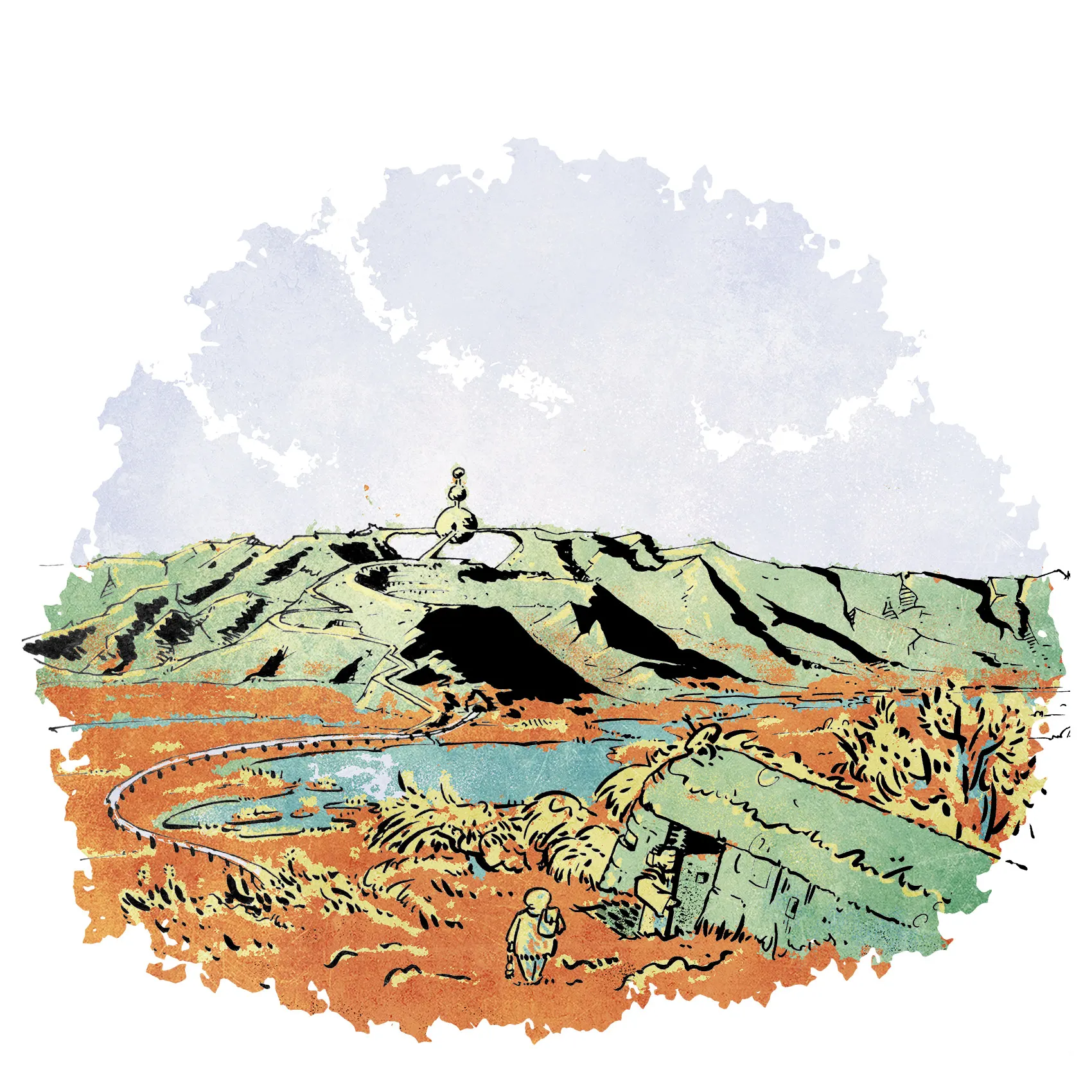
Interesting Idea. Give the PC an extra effect or flavor if they succeed. To spice things up, give their opponents a free counter if the attempt fails (or a bonus on their turn).
Great Idea. Give the PC a bonus on their attempt. For a bit of temptation, you can offer extra options (with extra dangers).
Adjudicating Action Ideas Not only can the players come up with new actions, they are encouraged to. Fortunately, most player ideas fall into one of four categories, making improvisation a little easier for the referee.
Burdens From Damage Other obnoxious attacks, powers, curses, and circumstances can impose specific burdens on characters. These occupy inventory slots, reducing a character’s options, imposing situational penalties, and imposing additional penalties to rolls as they accumulate in a character’s burden inventory. Most effects that impose burdens would allow a save. The worst would not. PCs without the inventory space to gain an additional burden roll on the defeat table. Remember that each burden in the burden inventory applies a -1 penalty to all rolls, including defeat table rolls ...
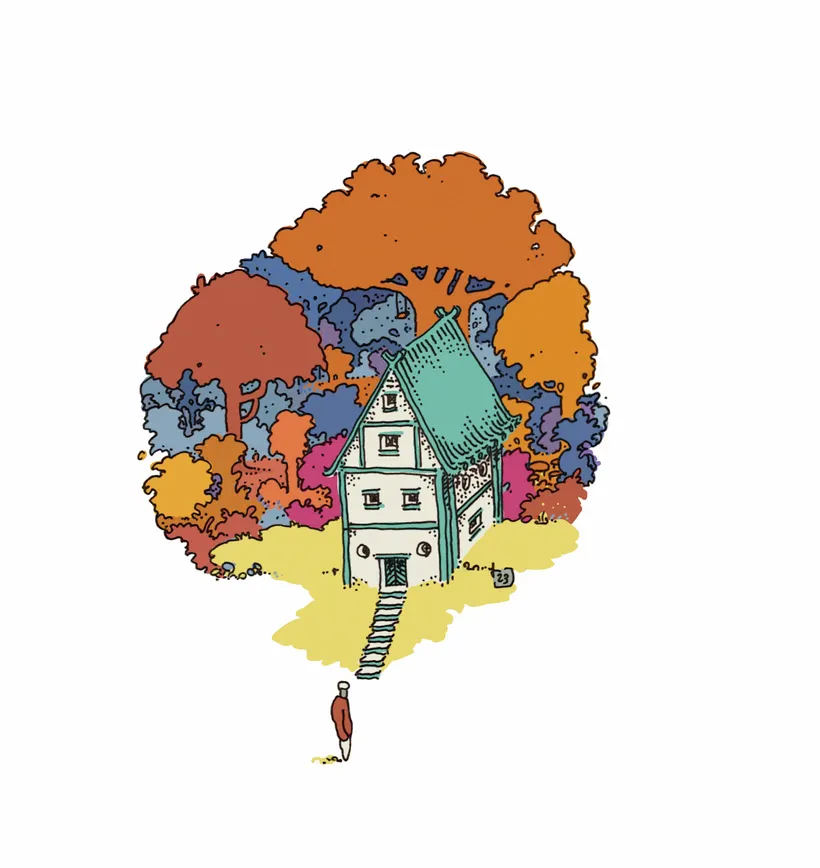
The referee uses common sense and the conflict time frame to put a stop to nonsense like stacking a dozen free actions to time lock an enemy and explode it from the inside out with some obscurely argued item edge case. Traits and items may provide additional free actions.
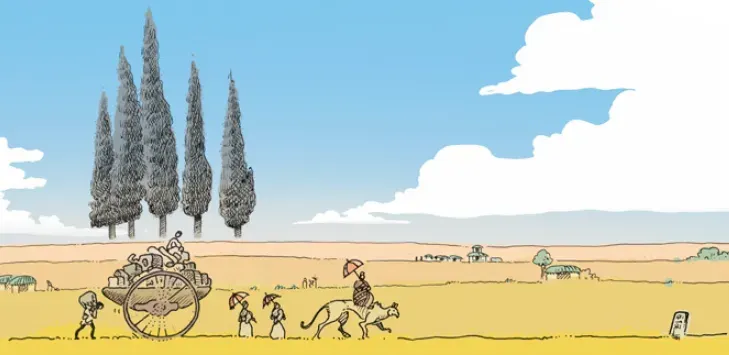
Jab the exposed flank of an oblivious foe shoving past you with your elbow (or a shiv).
Drop to the ground.
Concentrate on one thing.
Concentrate on one thing.
Chew gum.
Ability Score Damage Some obnoxious attacks, traps, curses, or situations reduce ability scores: strength, endurance, agility, charisma, aura, or thought. These are serious shocks, which always carry the risk of death. PCs who cannot reduce an ability score because it is already at 0 roll on the defeat table. NPCs without defined abilities who suffer ability score damage reduce their level and attack bonus instead. If either would be reduced below 0 by ability score damage, they become an ex-NPC. NPCs without defined abilities who suffer ability score damage reduce their level and attack bonus instead. If either would be reduced below 0 by ability score damage, they become an ex-NPC.
Amble nonchalantly.
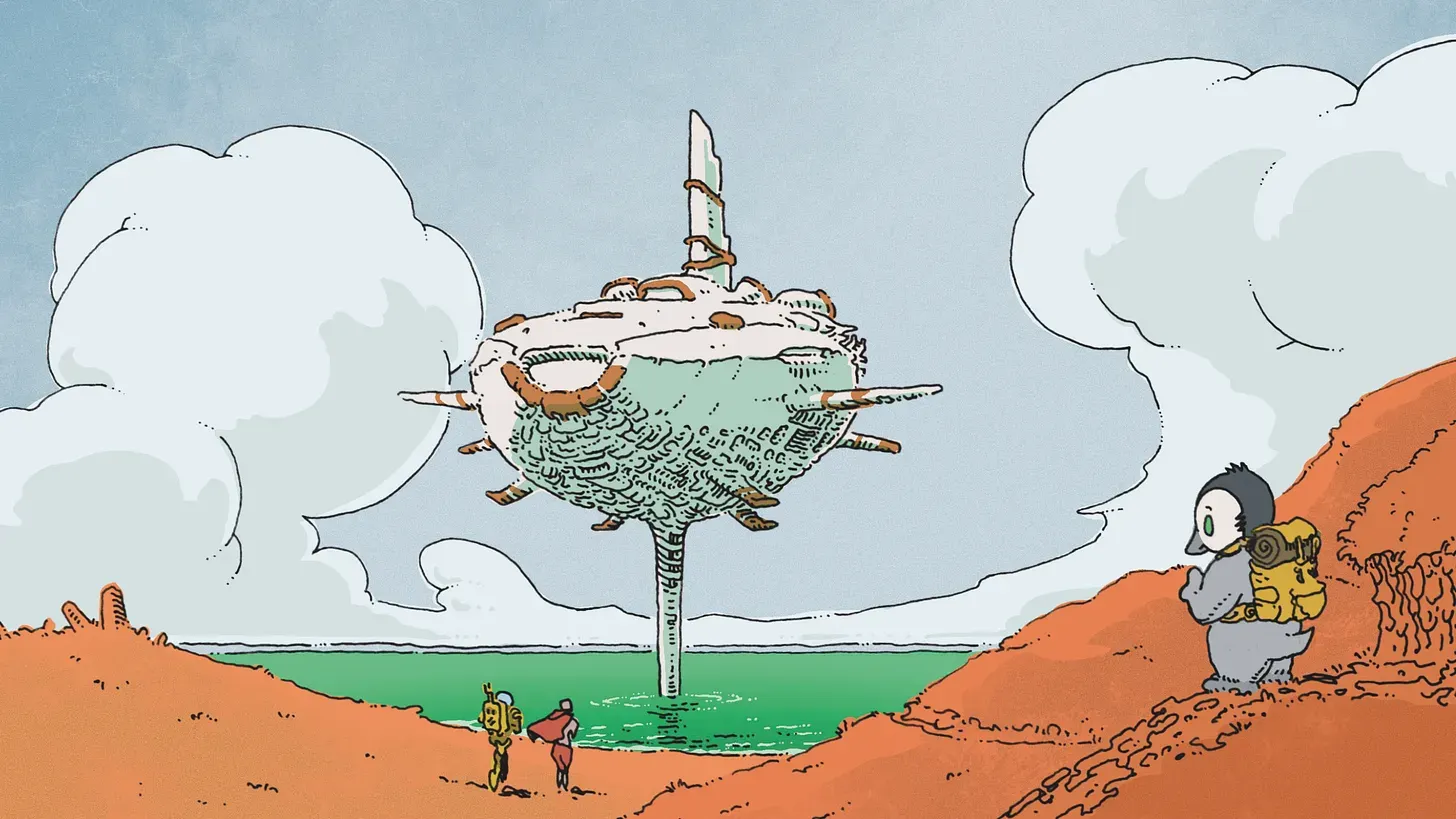
Free Actions Some actions, such as dropping a carried sack or responding to an opponent’s folly (such as their critical failure), are free actions. A character can take at least one free action per round. Typical free actions in an ordinary conflict:
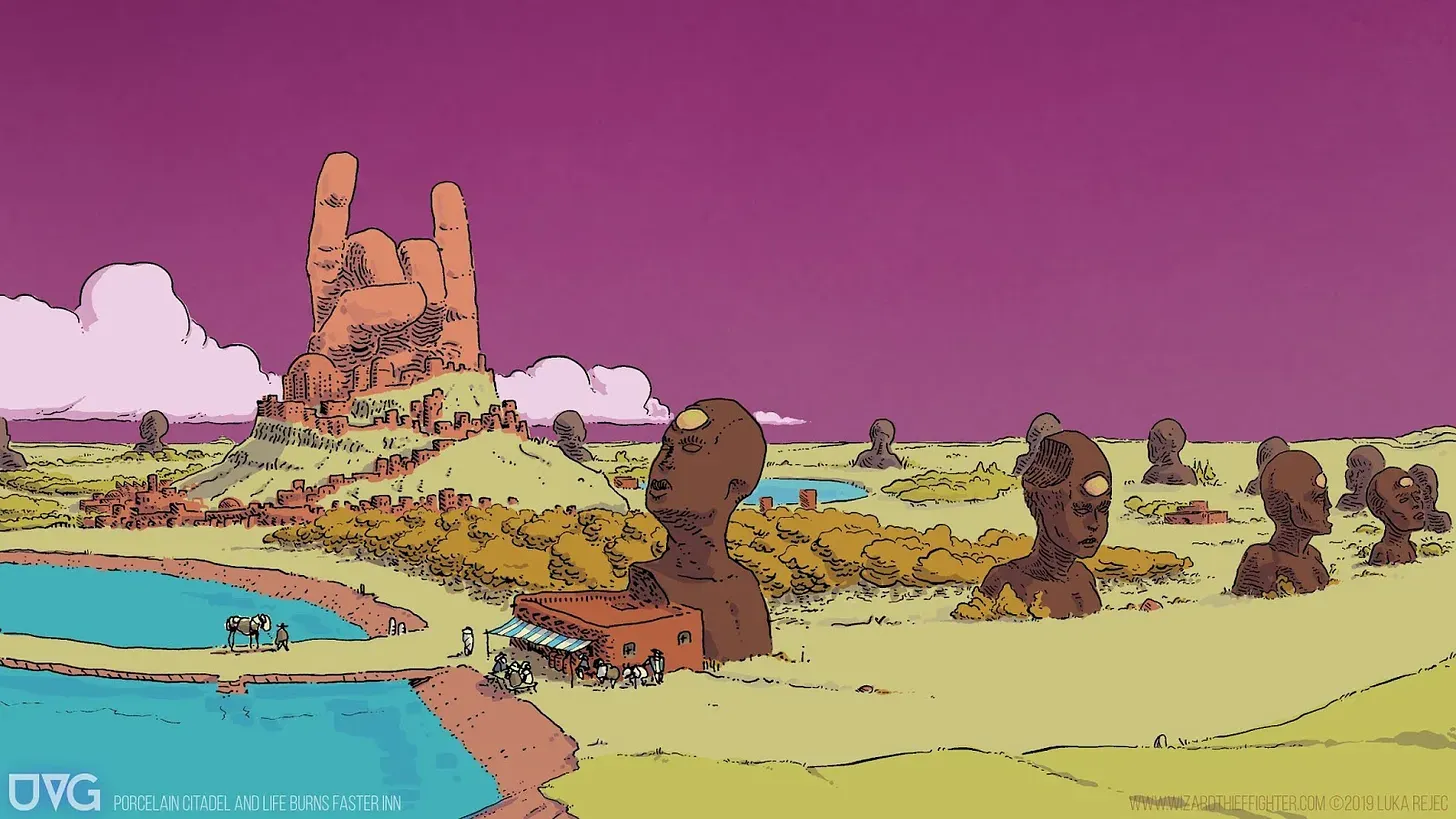
Action On their turn, a character can do nearly anything the player comes up with. The referee adjudicates whether it requires any die rolls and whether bonuses or penalties are called for. Most turns, a character does some reasonable combination of movement through space and interaction with the environment and other characters.
Damage in Deadly Combat In straightforward combat, such as while dungeoncrawling, fighting in a pitched battle, or other classic scenario, the stakes are life and death. The referee makes these stakes clear when the party enters such an environment, or when a conflict escalates. In these circumstances: PCs reduced to 0 life roll on the defeat table. NPCs become ex-NPCs at 0 life. This does not mean they are dead, but they are out of the fight for the rest of the scene. Most sentient NPCs do not want to be ex-NPCs and flee before. The referee may optionally roll on the defeat table for important or Named NPCs.
Turn Each round, each character gets a turn when their side acts. Most turns, a character does some reasonable combination of movement through space and interaction with the environment and other characters.
Damage is Abstract Reducing life doesn’t (necessarily) mean sprays of arterial blood. The precise effect depends on the narrative stakes. A creature could be gossipped to death, metaphorically. Once harangues and threats reduce it to 0 life, it might retreat, step aside, or be too brow-beaten to resist a killing blow.
Chaos Reigns When initiative rolls are tied, chaos reigns and everything happens at once. The PCs and their opponents take their turns, but damage and afflictions only take effect at the end of the round. This is how two swellswords stab one another right dead and proper.
Suffering Damage All damage, unless specified otherwise, reduces a target’s life. Some powerful items or powers may reduce abilities or levels, deplete defenses, or impose other burdens and conditions.
Initiative d6 + agility Each side rolls initiative every round. For the players, a random PC rolls every round. High roll goes first. The players decide their characters’ turn order when their side acts.
Rounds - Time Enough When a conflict breaks out, play proceeds in rounds. The length of a round is cinematic, not precise. It’s long enough to do something meaningful. In a duel, a round might last mere seconds (often 6), with airships chasing each other, it might last a minute or an hour.
Damage, Defeat, Death As attacks land, as powers drain, a character suffers damage. Once a character has suffered enough damage, they risk defeat (and death). A character’s attributes are resources. Life is used to activate powers. Ability scores improve rolls. Hero dice boost results. Sacrifices turn near misses into successes. However, attributes are also a buffer protecting a character from defeat and death. The more spent to succeed, the greater the risk of sudden defeat.
The winning side may get one final shot. The conflict ends and they survey the spoils of their victory.
After a few rounds, one side or another will usually try to flee, retreat or surrender — either because of a morale roll (the npcs) or the players’ decision (the party).
[Optional] Hammerspace Hallmarks Besides their other benefits, hallmarks do not occupy ordinary inventory slots. Draw a hallmark box on your character sheet with one slot for each of your character’s levels.
Conflicts unfold in Rounds. Each round, the sides roll initiative to determine who goes first. The sides then take turns to act.
2) a +1 defense bonus (for example, a vehicle or shield);
Conflicts are rarely inevitable. Often, Reaction rolls determine how NPCs react.
The referee outlines dangers before a conflict breaks out.
1) a +1 bonus to every damage die rolled (so 2d4 becomes 2d4+2);
Conflict Mechanics Since conflicts are risky for the PCs, their procedure is more defined than most other game mechanics:
A PC can own a number of hallmarks equal to their level. All hallmarks start as level 0 items unless specified otherwise. Levelling up hallmarks costs as much xp as with any character. Each level, a hallmark gains one of the following:
Overwhelmed Flee, Flop, Freeze, & Fawn People and creatures who feel threatened by the PCs may flee instead of attacking. Creatures that feel particularly overwhelmed may beg for mercy, cower in terror, or offer to serve their new tyrants.
Hallmarks Anything that belongs to a PC can become their hallmark. This might be a vehicle, a sword, a power or something more unusual. Heroism rubs off on belongings.
Over 12 They insist on helping, even if you don’t need help. Rude to say no, but they will waste your … Oh, dear. Cup of tea?
Units of Mind Paths (things that could be used as skills), ideas, backgrounds, mutations, spells, powers. Thankfully, even as your skill grows, it occupies no more space in your soul’s spark.
2 Aggressive, hostile. They attack, given half a chance. 3-5 Thanks, they hate you. 6-8 Unsure, waffling, complicated, suspicious. 9-11 Polite, understanding, sympathetic. 12 Friendly, interested. They’ll help, given half the chance.
Under 2 They come at you, like raving agents of cosmic corruption. Aggressive, hostile. They attack, given half a chance.
1 stone (st) = 14 lb = 6.35029 kg 1 stone (st) = 10 soaps (sp) 1 stone (st) = 250 cash (€, silver) 1 sack (sk) = 10 stones (st) 1 sack (sk) = 100 soaps (sp) 1 sack (sk) = 2,500 cash (€, silver)
Reaction - An Oracle of Behavior A random PC rolls 2d6 + cha to see how the NPCs behave. To provoke a conflict, subtract their charisma from the reaction roll instead. Some traits may modify reaction rolls. The referee may apply modifiers depending on appearance/behaviour.
Units of Matter Items, things. You can carry a packed sack, even if your strength implies otherwise and your are burdened. Cash? One cash is what a median laborer earns in a day. How do you know this? Why?
Additional Inventories Traits and containers can create new inventories. Draw these on your character sheet.
The Skilled Dice Oracle When a PC asks questions and their skill or ability would play a factor, roll d20 + modifier on a table such as this: 3- Nay and woe! 4–7 Nay 8–13 Perhaps, for a price 14–19 Yea 20+ Yea and more!
The referee can set up oracle die tables to suit the the odds they want. 2d6 offers a bell curve, 1d10 offers more options, etc. Most random tables in the UVG work as oracles.
Burdens Every occupied slot beyond a character’s trait or item inventory limit is a burden. Each burden imposes a -1 to all rolls. A character with 20 burdens can no longer take any actions. Some dangerous monsters may impose burdens with every successful attack, or even with their mere presence. Dropping cumbersome items is a quick way to reduce a character’s burdens. Removing afflictions is harder, usually requiring rest and care
d6 Random Event Table 1–3 Common or expected outcome (50% odds) 4–5 Uncommon or unusual outcome (~35% odds) 6 Rare or exceptional outcome (~15% odds)
Afflictions Curses, diseases, mutations, corruptions and other afflictions also occupy inventory slots. Spiritual and psychological afflictions generally occupy trait slots, while diseases and physical injuries occupy item slots.
The Dice Oracle When a player, including a referee, does not know what might happen in a situation, and there is little risk, rolling dice on a table gives a working answer.
Prosthetics and Augments Each implant or modification occupies a trait or item inventory slot.
Powers and Spells Each power or spell occupies a trait or item inventory slot. This represents either a magical anchor or the engraved psycho-physical channels that grant the character access to this unnatural power.
Pets and Sidekicks Each of a character’s pets and sidekicks occupies a trait or item inventory slot. This represents the character’s care and attention.
Non-humans may bear more or less. Some traits may expand inventory slots.
Traits: 7 + ability (Thought) slots Items: 7 + ability (Strength) slots Burdens: 20 slots
Inventory and Burdens A character’s inventory slots are a key game resource. Though a character might want to carry everything, the cruel laws of their synthetic reality forbid it. Every human PC has three basic inventories:
History shows again and again How nature points out the folly of men —Godzilla, Blue Öyster Cult, Spectres (1977)


